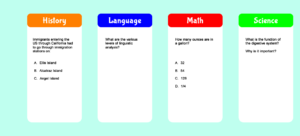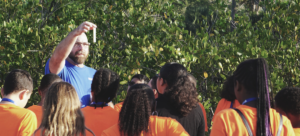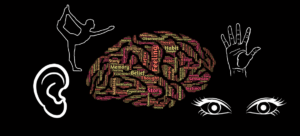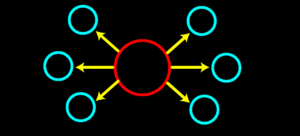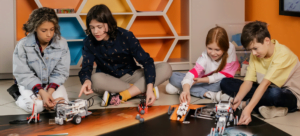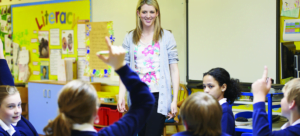Active learning is an educational method that focuses on engaging and involving learners in the learning process. It goes beyond traditional teaching methods, such as lectures and reading, and encourages students to proactively participate in their own learning.
At its core, it is about giving students agency over their education. By providing students with a platform to exercise their knowledge, active learning can help them develop the confidence they need to thrive both inside and outside of the classroom.
Additionally, active learning is an effective way for teachers to assess their students’ understanding of the material. Through activities such as group assignments, discussions, presentations, and projects, teachers can observe their students’ progress in real-time and effectively tailor the instruction to meet their needs.
Active Learning Strategies
There are several techniques or approaches used in education and training to engage learners actively in the learning process. These strategies go beyond traditional passive learning methods, such as lectures or reading, and aim to enhance understanding, retention, and application of knowledge. In addition, these strategies encourage learners to participate, collaborate, and think critically, leading to a deeper grasp of the subject matter.
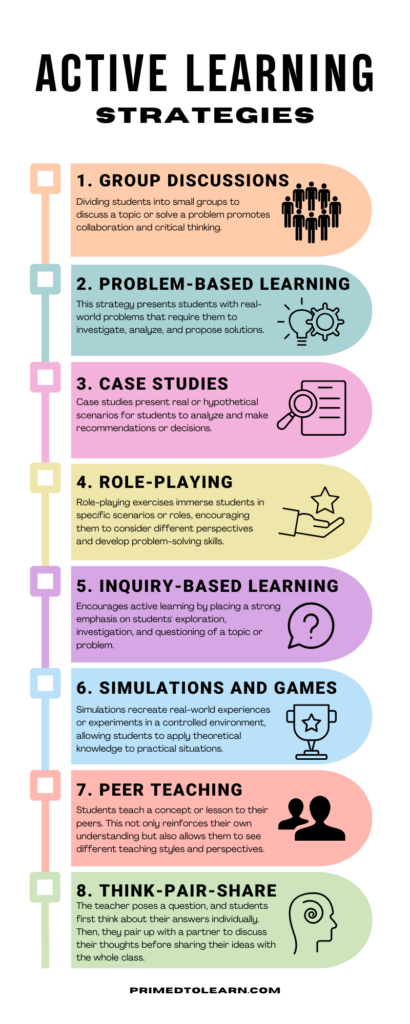
1. Group discussions
Group discussions are a cornerstone of active learning strategies, encouraging students to engage with the material and their peers in a dynamic way. This approach takes learning beyond passive absorption of information, fostering critical thinking and enhancing comprehension.
For instance, in a history class, the teacher could divide the students into groups and assign each the task of debating the causes and effects of a significant event, such as the French Revolution. Each group would need to research, prepare arguments, and present their findings to the rest of the class. This interactive process not only enriches their understanding of the subject matter but also develops their communication and teamwork skills.
Similarly, in a literature class, group discussions could be centered around interpreting a complex piece of literature. Each group could be assigned different themes or character arcs to analyze and discuss. This strategy facilitates a deeper understanding of the text, as students learn from each other’s perspectives and insights.
2. Problem-based learning
“Problem-based learning” is a dynamic active learning strategy that encourages students to address complex, challenging problems with no single “correct” answer. The goal here isn’t just to solve a problem, but to cultivate critical thinking, problem-solving skills, and a deep understanding of the subject matter.
For example, in a biology class, instead of simply lecturing about photosynthesis, the teacher might present a real-world problem such as the impact of climate change on plant life. Students are then tasked to use their current knowledge, along with research, to understand how changes in sunlight, temperature, and CO2 levels might affect the process of photosynthesis.
Similarly, in a business or economics course, students could be presented with a case study of a struggling company. Their task would be to analyze the financial data, market trends, and company operations to propose strategies and solutions to turn the company around. This immerses students in real-world scenarios and allows them to actively engage with the material, making learning far more effective and meaningful.
3. Case studies
In the realm of Active Learning Strategies, ‘Case Studies’ stand out as an effective tool to enrich the learning experience. Case studies provide students with realistic scenarios that require them to apply theoretical concepts, enhancing their analytical and problem-solving skills.
For instance, business students may be presented with a case study about a struggling company. They would be expected to identify the root cause of the issues and propose viable solutions, using the business theories and models they’ve learned.
Similarly, in medical education, case studies often involve patient histories and symptoms, requiring students to diagnose and suggest treatment plans. Thus, case studies offer a practical, scenario-based approach to learning, encouraging students to actively engage with the subject matter and apply their knowledge in a real-world context.
4. Role-playing
Role-playing is a dynamic active learning strategy that encourages students to immerse themselves in the personas of fictional characters or real-life personalities. It stimulates critical thinking, enhances communication skills, and fosters empathy by allowing learners to see scenarios from multiple perspectives.
A practical example of this strategy could be a History lesson on World War II. Students can be assigned roles of world leaders, soldiers, or civilians during that era, tasked with researching their characters and recreating pivotal moments of the war. This not only provides a more profound understanding of historical events but also fosters appreciation for the complexities of decision-making during war-time.
Another example could be in a Business Education class where students role-play as executives of a company, making critical decisions about marketing strategies, budget allocation, and staff management. This offers them a practical insight into business operations and management, preparing them for real-world scenarios.
5. Inquiry-based learning
Inquiry-based learning is an active learning strategy that fosters curiosity and encourages learners to seek answers to their own questions. This approach turns traditional teaching on its head: instead of starting with facts, we start with curiosity!
Let’s dive into a practical example. Imagine you’re teaching a biology class and the topic is photosynthesis. Instead of starting with a lecture, you kick off the class with a question: “How do you think plants get their energy?” This sparks a discussion, with students sharing their thoughts and ideas. You then guide the students to set up an experiment with two plants – one kept in the sun and the other in the dark – to observe and record their growth over a few weeks. This hands-on inquiry-based activity will not only engage them but also cement their understanding of photosynthesis in a much deeper and personal way.
Inquiry-based learning allows students to learn by doing, and in the process, they develop problem-solving and critical thinking skills that are crucial in the real world.
6. Simulations and games
Simulations and games are highly effective active learning strategies that foster student engagement and promote critical thinking. They are designed to mimic real-world situations, allowing students to apply their theoretical knowledge in a practical, risk-free environment.
For example, in a Business Studies course, students might participate in a stock market simulation game. This game lets learners buy and sell imaginary stocks in a virtual stock market environment. They make decisions based on real-time data, helping them understand the impact of market trends, economic indicators, and global events on stock prices.
Similarly, in a History class, a teacher might facilitate a role-play exercise simulating the signing of a historical treaty. Each student assumes the role of a key figure present during the event, recreating the negotiation process. This not only brings history alive but also helps students develop negotiation and diplomacy skills they’d not ordinarily have the chance to practice.
Through simulations and games, learners can practice complex skills and make decisions in a controlled, supportive environment, enhancing their understanding and retention of course content.
7. Peer teaching
Peer teaching, a cornerstone of active learning strategies, is a method where students teach or learn from each other. By fostering a cooperative learning environment, peer teaching encourages students to engage deeply with the material, enhancing their comprehension and critical thinking abilities.
A practical example of peer teaching could be a group project in a history class. In this scenario, each student could be assigned a specific period or event, and then be asked to teach their peers about it.
Another example might involve a math class where students who have mastered a particular concept help their classmates solve problems using that concept. This not only reinforces the knowledge of the “peer teacher,” but also provides a different teaching perspective for the students struggling with the concept.
8. Think-pair-share
Think-Pair-Share is a dynamic active learning strategy that promotes critical thinking and peer-to-peer collaboration. The process begins with the instructor posing a question to the class. Students are then given time to think about their response individually (“Think“). Following this, students pair up to discuss their thoughts (“Pair“), promoting a deeper understanding through dialogue. After the discussion, pairs share their insights with the whole class (“Share“), fostering a communal learning environment.
Let’s consider a practical example in a history class studying the American Civil War. The teacher might ask, “What are some possible factors that led to the outbreak of the Civil War?”.
For the “Think” part, students might jot down factors like economic disparities, states’ rights, and the issue of slavery. During “Pair“, students might debate the significance of each factor, perhaps realizing the interconnectedness of these issues.
Finally, during “Share“, students would present their thoughts, engaging in a class-wide discussion that brings in multiple perspectives and deepens everyone’s understanding of the complex causes of the Civil War.
These strategies can be adapted and combined to suit various learning environments, subjects, and age groups. The goal is to foster an interactive and engaging learning experience that promotes critical thinking, problem-solving, collaboration, and retention of knowledge.
8 Benefits of Active Learning
Here are some of the key benefits for learners:
1. Enhanced Understanding
Active learning promotes deeper understanding of the subject matter. By engaging in activities that require critical thinking, problem-solving, and analysis, learners develop a more comprehensive understanding of concepts and principles.
2. Improved Knowledge Retention
Active learning strategies encourage learners to actively process and apply information, which enhances knowledge retention. By participating in hands-on activities and discussions, learners reinforce their understanding and memory of the material.
3. Development of Critical Thinking Skills
Active learning fosters the development of critical thinking skills, such as analyzing, evaluating, and synthesizing information. By engaging in activities that require higher-order thinking, learners become skilled at critically examining information and making informed judgments.
4. Application of Knowledge
Active learning provides opportunities for learners to apply their knowledge to real-world situations. By engaging in problem-solving tasks, case studies, simulations, or role-playing activities, learners develop the ability to transfer their knowledge and skills to practical contexts.
5. Increased Engagement and Motivation
Active learning promotes learner engagement and motivation. By actively participating in the learning process, learners become more invested in their own education, resulting in higher levels of motivation, curiosity, and interest in the subject matter.
6. Collaboration and Communication Skills
Many active learning strategies involve group work and collaborative activities. By working together, learners develop communication and teamwork skills, learn from different perspectives, and benefit from the collective knowledge and experiences of their peers.
7. Preparation for Real-World Challenges
Active learning prepares learners for real-world challenges by simulating authentic situations. By engaging in problem-solving, decision-making, and critical analysis, learners develop the skills necessary to navigate complex issues and adapt to evolving circumstances.
8. Lifelong Learning Skills
Active learning promotes lifelong learning skills and habits. By engaging in self-directed learning, taking ownership of their education, and developing effective learning strategies, learners cultivate the ability to continue learning and adapting throughout their lives.
The Teacher’s Role in Active Learning
In active learning, the role of the teacher or instructor shifts from being the sole disseminator of information to that of a facilitator, guide, and mentor. Here are some key aspects of the teacher’s role in active learning:
1. Designing Learning Experiences
The teacher plays a crucial role in designing and planning engaging learning experiences that incorporate active learning strategies. They select appropriate activities, create relevant materials, and structure the learning environment to promote student engagement and participation.
2. Facilitating Discussions
The teacher facilitates discussions and encourages active participation among students. They ask thought-provoking questions, encourage critical thinking, and ensure that all voices are heard. The teacher guides and mediates discussions, helping students explore ideas, challenge assumptions, and develop deeper insights.
3. Providing Guidance and Support
The teacher provides guidance and support to students as they engage in active learning activities. They offer clarifications, scaffold learning, and provide feedback to help students navigate challenges and stay on track. The teacher serves as a resource and mentor, assisting students in their learning journey.
4. Creating a Supportive Environment
The teacher fosters a supportive and inclusive learning environment that encourages active participation and collaboration. They create a safe space where students feel comfortable expressing their thoughts, asking questions, and sharing ideas. The teacher promotes respect, open-mindedness, and constructive dialogue among students.
5. Monitoring Progress and Adjusting Instruction
The teacher monitors students’ progress and understanding throughout the active learning activities. They observe and assess student performance, provide timely feedback, and identify areas where further instruction or clarification may be needed. The teacher adjusts their instruction based on students’ needs, ensuring that the learning objectives are met.
6. Encouraging Reflection and Metacognition
The teacher encourages students to reflect on their learning process and develop metacognitive skills. They guide students in analyzing their thinking, identifying strengths and areas for improvement, and setting goals for further learning. The teacher helps students develop a deeper understanding of how they learn best and supports them in becoming self-directed learners.
7. Inspiring and Motivating Students
The teacher plays a vital role in inspiring and motivating students to actively engage in their learning. They create enthusiasm for the subject matter, highlight the relevance of the activities, and connect the learning to real-world applications. The teacher celebrates student successes, encourages perseverance, and fosters a love for learning.
In active learning, the teacher serves as a facilitator of knowledge and a catalyst for student growth. They create an environment that encourages active participation, critical thinking, and collaboration, while providing guidance, support, and feedback to help students succeed in their learning journey.
Active Learning Challenges
While active learning offers numerous benefits, there can be challenges associated with its implementation. Here are some potential challenges to active learning and strategies to overcome them:
1. Resistance to Change
Some students and even instructors may be resistant to adopting active learning methods, especially if they are accustomed to traditional lecture-based approaches. Overcoming this challenge requires creating awareness of the benefits of active learning and providing evidence of its effectiveness through research and examples. Gradually introducing active learning strategies, providing clear explanations, and highlighting student success stories can help alleviate resistance.
2. Time Constraints
Active learning activities may require more time compared to traditional lecture-based methods. It can be challenging to cover the desired content within limited class time. To address this, careful planning and time management are essential. Teachers can prioritize key concepts and design focused, time-efficient activities that align with learning objectives. Breaking longer activities into smaller segments and integrating them strategically throughout the course can also help maximize learning opportunities.
3. Classroom Size and Resources
Large class sizes or limited resources can present challenges for implementing certain active learning strategies. To overcome this, instructors can use strategies such as dividing students into smaller groups for discussions, utilizing technology for virtual collaboration, or adapting activities to suit the available resources. Group work can be structured in a way that allows for efficient participation and engagement, regardless of class size.
4. Unequal Participation
In active learning activities, some students may be more hesitant to participate or may dominate discussions, while others may be less engaged. To address this, instructors can establish clear expectations for participation, create inclusive environments that encourage all students to contribute, and use strategies like think-pair-share or random selection to ensure equal opportunities for participation. Providing feedback and recognizing diverse perspectives can also foster an inclusive learning atmosphere.
5. Assessment and Grading
Traditional grading methods may not easily align with active learning approaches. Active learning emphasizes the process of learning and understanding rather than solely focusing on outcomes. To address this challenge, instructors can consider alternative assessment methods such as group projects, portfolios, presentations, or reflective journals that capture students’ active engagement, critical thinking, and application of knowledge. Clear grading rubrics can guide students and ensure transparency in the assessment process.
6. Instructor Training and Support
Instructors may require training and support to effectively implement active learning strategies. Professional development opportunities, workshops, or collaboration with colleagues who have experience with active learning can help instructors gain confidence and acquire effective facilitation techniques. Engaging in communities of practice or seeking mentorship from experienced active learning practitioners can also provide valuable guidance and support.
By acknowledging and proactively addressing these challenges, instructors can successfully implement these learning strategies and create engaging and meaningful learning experiences for their students. Flexibility, adaptability, and ongoing reflection on the effectiveness of different strategies are key to overcoming challenges and maximizing the benefits of active learning.
Conclusion
Active learning is a powerful tool that can help students engage with material in meaningful ways and make the most of their education. By utilizing these strategies, instructors are able to create interactive classrooms where students have opportunities for collaboration and exploration. Through this approach, educators can tailor their teaching methods to match each student’s individual needs while also encouraging critical thinking skills and problem-solving abilities. We hope this blog post has given you insight into how to use these techniques effectively in your classroom or educational program!



